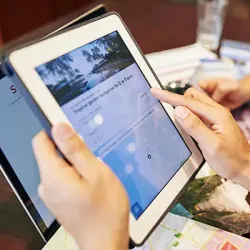Industry Knowledge
On-demand Delivery Services in the New Normal
Early 2020 saw us traveling, shopping, and enjoying our meals in the most talked-about places. After all, these activities were just an inconsequential part of our everyday experiences.
That is, until the pandemic came along. We all know it full well now, and to say that COVID-19 caused a bit of a stir is a huge understatement. Around the globe, businesses of all sizes had to make big, critical choices almost overnight.
As the world saw deserted streets and empty shops behind the safety of their screens; the restaurant, transportation, and travel industries struggled with sweeping, monumental realities. Some knew these transformations were down the road, but most weren’t even expecting them to occur at this point in time.
Much has changed this 2021—and these industries are forever altered.
Restaurants Either Embraced Technology and Survived, or Didn’t
One of the most hard-hit by the pandemic is the food service industry, particularly restaurants. Some full-service restaurants managed to depend on and discover a way to make their multi-course meals available for delivery. Many quick-serve and fast-food restaurants also developed delivery and drive-thru channels.
Digital solutions that helped restaurants lighten customer safety fears and comply with restrictions boomed, and technology providers scrambled to offer new products to get restaurants on board. Technologies like digital menus, QR codes, contactless ordering, and payment at the table suddenly became the norm.
Trending ideas like virtual restaurants, ghost kitchens, and delivery-first brands went from unusual ideas on the horizon to caption discussions as the industry looked for ways to adapt and survive.
What we saw less of was the fun stuff like robotic cooks and waiters, AI-powered ordering systems, and drone delivery as the industry focused on getting through a tough year.
What’s in Store for 2021?
The smart money is on a strong growth trajectory in the first quarter of 2021. Experts are predicting 20% to 25% growth compared to last year, according to this report. However, they also see a decline from 2019 figures, saying that it will take a few years to return to pre-pandemic numbers.
Consumers are embracing online ordering, as well as curbside pickup and delivery. Diners are looking forward to returning to normality, too. Restaurants, if they didn’t realize it already, have seen firsthand the need to invest in technology, or be left behind. It goes without saying that technology is going to play a huge part in the restaurant industry recovery1.
E-commerce and Transportation Innovations
Online shopping and food delivery were on a slow and steady rise for years, but it was the COVID-19 pandemic that forced businesses and consumers to jump on the digital and mobile bandwagons even more quickly than predicted.
The pandemic presented some of our time’s biggest challenges, spanning all-encompassing innovations across various E-commerce and transportation functions. Here’s what you can expect to see more of in 2021:
- Home delivery volumes—especially in food and beverage—will continue to rise. The most significant growth stems from grocers, farms, and food hubs; meal prep and meal kit companies; and businesses delivering bottled beverages like water, cold-pressed juices, wine, and beer.
- Consumers will continue to shop online and have products delivered to their door. While COVID-19 helped consumers make the switch from in-person to online shopping, there is data to suggest that this switch to online is here to stay. New habits picked up during the COVID-19 pandemic will continue even after the pandemic is over, according to research2 from McKinsey.
- Everyone wants to support local. The campaign to support local businesses is picking up steam like never before, and the local food movement is riding that wave. Local food is experiencing a renaissance, thanks to the restrictions brought by COVID-19.
- Customers expect more from their delivery experience. The delivery experience is more personal than before. Emails and SMS updates get customers’ attention because they want to know when their order arrives and how they can best plan to receive it. They can organize a time to be home, give authority to leave the delivery at the door, or arrange re-delivery.
- Technology to help food businesses stay flexible and scale operations. Those who managed to quickly pivot their operations when the pandemic hit are now rallying strong. These businesses have set up an online shop, carving out space in their facility to store and pack home delivery orders, and then integrating dynamic routing technology to plan and execute on hundreds of home delivery orders3. They successfully weathered the waves of the pandemic and are now thriving.
Given consumer behavior, enduring purchasing habits, and strong technology trends, delivery and takeout, in general, continue to be important in 2021. For businesses to thrive in this landscape, they have to have the pulse on consumer demand and see how it drastically transformed the way restaurateurs think about delivery over the last year—and how all these will affect their future.
What ultimately binds all these trends is customer experience, and the vital role it plays in businesses when it comes to handling historical, global curveballs while keeping pace with everyday challenges. TaskUs’s partnership with on-demand food delivery companies indicates that an efficient customer care strategy can provide a distinctive experience that will help companies build a loyal customer base that will tide them over during these tough times—and even help them thrive.
By incorporating vigorous training, cutting-edge tools, and hard-earned learnings, TaskUs can support these clients, and help them build customer loyalty and trust, even in the face of uncertainty.
References

We exist to empower people to deliver Ridiculously Good innovation to the world’s best companies.
Useful Links







